|
|
|
Sort Order |
|
|
|
Items / Page
|
|
|
|
|
|
|
| Srl | Item |
| 1 |
ID:
186528
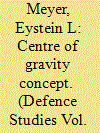

|
|
|
|
|
| Summary/Abstract |
This article applies grounded theory and epistemological, teleological, ontological, and methodological (ETOM) lenses to describe the prevalent contemporary theories of the centre of gravity concept, originated by Carl von Clausewitz. These include the theories of John Warden, Joe Strange & Richard Iron, Antulio Echevarria II, Milan Vego, Dale Eikmeier, and Jacob Barfoed. The article then compares the theories across 14 deduced theoretical aspects and produces a comparison matrix, that can be used as an analytical tool, and discusses implications as guidance for further research and doctrine development. The article argues that the term “centre of gravity” is polluted, and that the application of the term in military planning and doctrines requires careful attention to the specific theory being applied, so that logical consistency and clear, accurate communication is achieved. Alternatively, the concept may be removed from doctrine altogether, renovated with inclusion of a new unpolluted term, or reconstructed with removal of the centre of gravity, leaving a “critical factor analysis” concept behind. This article also provides a level of granularity to the debate about the concept, that renders critics like Paparone & Davis Jr and Zweibelson partly irrelevant and can provide a more nuanced and qualitative basis for future discussion.
|
|
|
|
|
|
|
|
|
|
|
|
|
|
|
|
| 2 |
ID:
186531
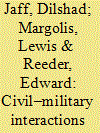

|
|
|
|
|
| Summary/Abstract |
Humanitarian agencies and military forces are increasingly interacting on the ground during humanitarian crises. These evolving relationships are often complicated and bring forward many implementation challenges. This paper repurposes this debate by describing three non-conflict humanitarian case studies and using them to reflect on the problematic history and applicability of formal frameworks and guidelines. Recommendations to improve the structures and processes for implementation of relief strategies are offered. If the delivery of humanitarian assistance during non-conflict humanitarian crises is to be efficient, civil–military interactions should receive greater systematic attention.
|
|
|
|
|
|
|
|
|
|
|
|
|
|
|
|
| 3 |
ID:
186529
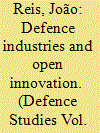

|
|
|
|
|
| Summary/Abstract |
The European Defence Industry is undergoing profound changes. Industrial activity is now operating on a quintuple helix innovation model with the deep involvement of universities and governments in innovation. In addition, military innovations are being transferred to civil society, with increasing attention paid to the environment. In the first stage, we report on the state-of-the-art of existing research using PRISMA protocol. The PRISMA technique is widely accepted by the academic community for its ability to discover concepts, ideas, and debates about the defence industry. In the second stage, we present a case study involving the Portuguese Defence Industry, for which multiple data collection sources were used to ensure triangulation and corroboration. The results show that, in the light of the quintuple helix innovation model, it was possible to bring applications from theoretical discussion to real life. Moreover, within the scope of the triple helix, it was possible to develop, produce and test military products, allowing to improve the military capacity of ground forces. In the future, ecological concerns will likely increase, so we suggest a greater focus on this area of research.
|
|
|
|
|
|
|
|
|
|
|
|
|
|
|
|
| 4 |
ID:
186543
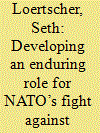

|
|
|
|
|
| Summary/Abstract |
As NATO drafts its next Strategic Concept, it faces a persistent and more diverse threat from terrorism than when the 2010 Strategic Concept was written. In addition, the Alliance faces greater threats from geopolitical competition, leading to its member states shifting resources away from the fight against terrorism. In drafting of the next Strategic Concept, NATO must continue to prioritize the development of an enduring and sustainable approach to maintain its focus on terrorist threats. This essay argues that a sustainable and enduring approach to fighting terrorism requires NATO to adopt three key tasks (1) improving the Alliance’s defensive capabilities, (2) maintaining its ability to respond to crises and (3) focusing on intelligence sharing. In order to ensure this approach is sustainable for the Alliance, NATO must implement these key tasks by focusing on and integrating terrorism within NATO policy and increasing collaboration with allies and multinational partners.
|
|
|
|
|
|
|
|
|
|
|
|
|
|
|
|
| 5 |
ID:
186540
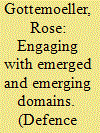

|
|
|
|
|
| Summary/Abstract |
Cyber, space, and emerging technologies have transformed the strategic environment. Since the last publication of the NATO Strategic Concept, the Alliance has responded to this changing environment by addressing emerged and emerging threats at differential rates of operational and policy planning. Now, NATO must seek to holistically integrate these domains into the forthcoming strategic concept to increase the resilience and effectiveness of the Alliance. An adaptable and resilient Alliance that responds to the challenge of cyber, space, and emerging technologies will be best realized through three primary avenues. First, reaching preemptive consensus on actions short-of-force and consensus on space and cyber actions that trigger Article 5 will enhance collective defense and crisis management. Second, communication of capabilities and resolve will promote deterrence and enhance cooperative security among member states. Finally, cooperation with industry partners and among Allies to maintain a cutting technological edge is essential for NATO’s collective defense against emerging threats and enhances cooperative security through a common strategic culture of innovation. It is essential that NATO prevents cyber, space, and emerging technologies from being understood and actioned in isolation, and instead thoughtfully integrates technologies into the Alliances’ key tasks.
|
|
|
|
|
|
|
|
|
|
|
|
|
|
|
|
| 6 |
ID:
186535
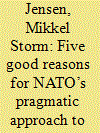

|
|
|
|
|
| Summary/Abstract |
For decades, few NATO members, predominantly the US, had the capabilities to conduct offensive cyberspace operations (OCO). Today more than half of NATO’s members have, or are acquiring, offensive cyberspace operations capabilities (OCOC). Historically, NATO’s planning and coordination is based on shared knowledge of the members’ military capabilities, to a degree even their nuclear capabilities. In the cyber domain, the principle has evolved to include allies’ emerging defensive cyber capabilities. NATO’s approach to OCOC, however, deviates radically: NATO’s doctrine merely integrates OCO’s effects, that is, allow members to contribute with OCOs in operations without sharing information with allies on what OCOCs are available or how the OCOs deliver the effects. OCOC’s technical and tactical characteristics incentivize NATO’s members to keep OCOCs secret, also from allies. This results in a dilemma: Either the allies providing OCOC’s effects risk sharing sensitive information on the means, or the allies, who depend on the provided effects, act without sufficient knowledge of the deployed OCOCs to assess their efficacy, legality, or impact on own offensive or defensive cyber operations. NATO’s limited approach to OCOC is a pragmatic mitigation of the dilemma that allows NATO to train and develop doctrine in the field further.
|
|
|
|
|
|
|
|
|
|
|
|
|
|
|
|
| 7 |
ID:
186536


|
|
|
|
|
| Summary/Abstract |
This article introduces ten essays capturing ten panel discussions held by the Department of Social Sciences at the United States Military Academy on 3-4 February 2022, in support of the drafting of NATO’s 2022 Strategic Concept. While the shadow of the Russo-Ukrainian war hung heavy over the proceedings, participants sought to take both a long and a broad view, contemplating NATO’s role in a changing international order. NATO allies must assimilate these changes into their collective and national strategies, but they are first and foremost agents themselves, whose strategies can and should shape the future. The participants asked challenging questions about what international order(s) might look like in the proximate future, and how NATO allies could shape that proximate future. The authors of this introductory essay contend that while simultaneous competition with China and Russia will be a (perhaps the) central feature of the international security landscape for years to come, the act of competing does not a Strategic Concept make. Allies must grapple with interrelated issues ranging from the evergreen question of transatlantic burden-sharing to the assimilation of emerging technologies into strategic and operational planning. The transatlantic security architecture anchored by NATO will have to be incorporated into a broader, global security network to manage competition with China and Russia while holding fast to the democratic values that are at NATO’s heart.
|
|
|
|
|
|
|
|
|
|
|
|
|
|
|
|
| 8 |
ID:
186534
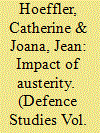

|
|
|
|
|
| Summary/Abstract |
While much scholarship takes austerity-driven spending cuts as evidence of policy change, this paper shifts the focus to interrogate whether these budgetary cuts lead to actual policy change and if so how. Scholarships on institutional change and public policy illuminate how state actors mediate policy change through coping strategies, i.e. strategies by which state actors try to minimize budget decreases’ negative impacts on policy. Taking French Defense Policy as an unlikely case of policy change, we show that state actors have adopted three types of coping strategies to minimize the spending cuts’ impact: compensation, delaying, and re-categorizing acquisition procedures. These coping strategies have however contributed to a process of incremental change, which most of time is non-cumulative and creates additional policy problems. This article contributes to a better understanding of change underway in defense policies, but also more generally to literatures pertaining to austerity and policy change.
|
|
|
|
|
|
|
|
|
|
|
|
|
|
|
|
| 9 |
ID:
186530
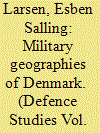

|
|
|
|
|
| Summary/Abstract |
Military geography is implicit in many geopolitical arguments that come with the increased great power competition. However, as military geography is one of the disciplines that informs and constitutes geopolitics it is prudent to move beyond geographical metaphors and make the military geography explicit in the argument in order to gain a better understanding of geopolitics. Using Denmark as a case, this article compares Danish military geography during the Cold War and now in the era of emerging great power competition. Danish military geography changed during the Cold War from a straits to a vulnerable flank. In the post-Cold War era, Denmark became a safe area at a long distance from expeditionary operations and is now emerging as a defendable staging area in the era of great power competition. This case shows that the military geography changed significantly with new technologies, strategies and the adversaries’ capabilities during the Cold War. We should likewise expect the military geography to be constantly changing in the new great power rivalry.
|
|
|
|
|
|
|
|
|
|
|
|
|
|
|
|
| 10 |
ID:
186527


|
|
|
|
|
| Summary/Abstract |
The Republic Act (R.A.) 10,349, otherwise known as the Revised Armed Forces of the Philippines (AFP) Modernization Program, is a recapturing of the AFP’s initial efforts at modernizing. Successor to R.A. 7898, the document reorients the priorities and the fiscal responsibilities of the Philippine government in ensuring the modernization of the armed forces into the twenty-first century. The concept of modernization 25 years onward has matured but it has barely deepened in implementation much to the detriment of AFP itself. Despite warnings of external security threats, the study has found nominal evidence hinting at the defence budget’s continuous prioritization of internal security threats. The study has likewise found that modernization funds set forth by R.A. 10,349 are not utilized to “modernize” the armed forces in the truest sense of the word. The study recommends addressing this issue of prioritization before any further attempt at military modernization.
|
|
|
|
|
|
|
|
|
|
|
|
|
|
|
|
| 11 |
ID:
186538
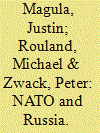

|
|
|
|
|
| Summary/Abstract |
Over the past decade, the North Atlantic Treaty Organization (NATO) has undertaken a strategic transformation to address various threats against the Alliance. Amongst those threats, Russia poses the most inimical and immediate challenge in terms of time, geography, and intent. Following Russia’s 2022 invasion of Ukraine, what could a strategic policy toward Russia for the next decades look like? What is needed to deter aggression against allies across all domains, to deter below the threshold of armed conflict and to de-escalate and terminate conflict above the threshold?
|
|
|
|
|
|
|
|
|
|
|
|
|
|
|
|
| 12 |
ID:
186542
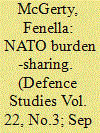

|
|
|
|
|
| Summary/Abstract |
How can NATO upgrade its understanding of (and metrics for) fair burden-sharing? Alliance burden-sharing is a lasting concern for the North Atlantic Treaty Organization (NATO) and will remain a focal point of the NATO 2022 Strategic Concept. Public discussions of NATO burden-sharing and the 2014 Defense Investment Pledge overemphasize defense expenditure and fail to account for alternative frameworks for understanding alliance burden-sharing and specifically, NATO’s optimal burden-share distribution. The U.S. Military Academy’s February 2022 NATO Strategic Concept Seminar featured a panel on burden-sharing frameworks and metrics. In this article, we present the main ideas and arguments, placed within the existing literature on alliance burden-sharing. We argue that, in the long-run, NATO can develop more fair, effective, and efficient burden-sharing arrangements by encouraging weapons and capability specialization, increasing inexpensive but influential operations such as advisory missions, and adapting flexible command and control structures when partnering with non-NATO actors on future battlefields. We argue that, in the short-run, NATO can refine the Defense Investment Pledge with a balanced focus on Cash, Capabilities, and Contributions while also extending the deadline for complete compliance with existing expenditure benchmarks until 2030.
|
|
|
|
|
|
|
|
|
|
|
|
|
|
|
|
| 13 |
ID:
186541


|
|
|
|
|
| Summary/Abstract |
National resilience, defined by NATO as a state’s ability to “resist and recover from a major shock such as a natural disaster, failure of critical infrastructure, or a hybrid or armed attack” must be at the forefront of discussions over the forthcoming Strateic Concept. What emerging challenges exist to national resileince, and how could NATO continue to evolve its response to these? How should our thinking evolve on deterring hybrid action and interference in democratic systems? This paper argues for four additional new national and alliance-wide resilience efforts: (1) a new baseline requirement for the protection of democracy; (2) efforts to reduce reliance on energy assets from non-NATO members, especially Russia; (3) mitigation initiatives to reduce the risk posed by foreign investment in vital infrastructure; and (4) the development of unambiguous standards for member state resilience.
|
|
|
|
|
|
|
|
|
|
|
|
|
|
|
|
| 14 |
ID:
186539


|
|
|
|
|
| Summary/Abstract |
NATO can ill-afford to dismiss the security and military implications of China’s increased presence and its relationship with Russia throughout the Euro-Atlantic area and along its periphery. The Alliance’s strategic calculus must include China across all relevant sectors including: security, economics, technology, and elite capture. The strategic concept should acknowledge that the Alliance needs to improve its awareness of China – starting with the psychology of the leadership in Zhongnanhai. There is no uniform vision amongst Chinese leaders vis-à-vis world order but four theories can be used to foster awareness: (1) moral realism, (2) relationalism, (3) symbiotic theory, and (4) Tianxiaism. Understanding the theoretical underpinnings of Chinese worldviews can help leaders of the Alliance mitigate strategic risk throughout the North Atlantic Area. Another way for NATO to reduce risk is to engage other nations in the Indo-Pacific region. The strategic concept should present a realistic approach to partnerships in the Indo-Pacific region that raise awareness, understanding, and trust with the Alliance. The new Strategic Concept should outline how NATO must do work “under-the-hood” to ensure it has a complete picture of China’s influence throughout the Euro-Atlantic area, starting with the creation of a NATO-China Council.
|
|
|
|
|
|
|
|
|
|
|
|
|
|
|
|
| 15 |
ID:
186545
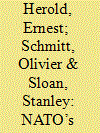

|
|
|
|
|
| Summary/Abstract |
Both China and Russia have become more assertive strategic actors since NATO last revised its Strategic Concept in 2010. What major strategic decisions do Russia, China, and other major powers face in the next decade? How should these changes be reflected in the next Strategic Concept? We argue that NATO must seriously address challenges from China and Russia through increased commitment, preparedness, and coordination of the conventional forces Allies make available. This may require a more integrated, ready, and responsive command headquarters that should be agreed by Allies with the 2022 Strategic Concept and implemented without delay.
|
|
|
|
|
|
|
|
|
|
|
|
|
|
|
|
| 16 |
ID:
186532
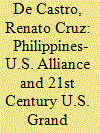

|
|
|
|
|
| Summary/Abstract |
This article situates the Philippines-U.S. alliance within the changing U.S. grand strategies from Barrack Obama’s rebalancing to Asia to President Joe Biden’s continuance of the Trump Administration’s strategic competition with China. Upon President Obama’s announcement of the rebalancing policy in 2011, the Philippines already figured prominently in the American security agenda in Asia, particularly with the intensification of the Philippines-China territorial dispute in the South China Sea. In 2016, President Rodrigo Duterte effected a major shift in Philippine foreign policy by distancing the country from the U.S. and gravitating toward China. The Trump Administration, however, saw the Philippines as a crucial ally in its geostrategic competition with China. Consequently, Washington adopted a policy of strategic patience to bring Duterte onside the U.S. rather than pushing him to China’s embrace. This scheme stabilized the two countries’ security relations and ensured the Philippines’ commitment to the U.S. system of bilateral alliances. In conclusion, the article argues that given the Philippines’ close security ties with the U.S. that often clash with China’s strategic interests and close Philippines-China diplomatic/economic relations, it will be difficult and challenging for President Duterte to pursue an independent foreign policy.
|
|
|
|
|
|
|
|
|
|
|
|
|
|
|
|
| 17 |
ID:
186537


|
|
|
|
|
| Summary/Abstract |
NATO and Realist International Relations theory were born of the same geopolitical concerns. Shaped as they were in the intense geopolitical competition of the post-World War II and early Cold War era, it is hard to imagine what either Realism or NATO would look like without the other (Johnston 2022). This observation frames our analysis of NATO as it enters a new period in which international relations is increasingly focused on geopolitical competition. What is NATO’s role in such a contested/competitive security environment and how should this be reflected in the Strategic Concept? We address NATO’s strategic response to global competition and what proven concepts from NATO’s geopolitical past are still relevant in this present geopolitical moment.
|
|
|
|
|
|
|
|
|
|
|
|
|
|
|
|
| 18 |
ID:
186544
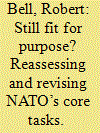

|
|
|
|
|
| Summary/Abstract |
NATO’s 2010 Strategic Concept established three core tasks for the Alliance: collective defense, crisis management, and cooperative security. While those tasks remain sound, the 2010 Concept reflected a different geopolitical, geostrategic, and security environment from today’s, characterized by renewed conflict with Russia, concerns about China’s strategic and economic ambitions, and new security challenges like hybrid threats and disinformation. Considering the changed strategic landscape and emerging challenges, we argue that NATO should make several refinements to its core tasks. European Allies must improve defense capabilities, ensuring their ability to help NATO meet its core tasks. In conjunction with the other Allied nuclear powers (the United Kingdom and France), the U.S. must renew its commitment to maintaining NATO as a nuclear alliance. NATO should adopt a more rigorous operational definition of crisis management, and a more systematic emphasis on the early warning and pre-crisis phases. Finally, while national “resilience” is already implied in Article 3ʹs requirement for member states to “maintain and develop their individual and collective capacity to resist armed attack,” adding it as a fourth core task would powerfully emphasize the need for allies to address new elements of resilience, to include both technological threats and democratic backsliding.
|
|
|
|
|
|
|
|
|
|
|
|
|
|
|
|
| 19 |
ID:
186546


|
|
|
|
|
| Summary/Abstract |
Since the Russian annexation of Crimea in 2014, NATO has returned to “its roots” (Pacuła 2021, 4). That reorientation has, of course, been sharpened further by the 2022 Ukraine crisis. Countering the Russian threat has once again become firmly established as NATO’s modus operandi (Schreer and Alberque 2022). For many commentators, this clarity of purpose is no bad thing. NATO had, so the argument runs, become over-stretched and ineffectual by taking on difficult missions such as that in Afghanistan where success was always ephemeral (Stapleton 2016). Better then, to concentrate on collective defense and deterrence – missions where NATO’s track-record is strong, its political-military assets well-established, and consensus clear (Ringsmose and Rynning 2021).
|
|
|
|
|
|
|
|
|
|
|
|
|
|
|
|
| 20 |
ID:
186533


|
|
|
|
|
| Summary/Abstract |
The world’s littorals is an important theater for all sorts of human interaction. So, also for naval warfare, which increasingly has led defense planners to focus on littoral capabilities rather than on Mahanian high-sea battles. We address the question of what littoral warfare means for different types of states. To that end, we develop a set of opposing ideal-types with regards to each type’s operational environment, aims, methods, and means for littoral warfare. We then use these ideal-types to analyze the naval doctrines of Sweden, the UK, and the US. This comparison generates some interesting results. For blue-water navies, littoral warfare is an additional burden and a high-risk endeavor, since the littoral, which the planning concerns is somebody else’s. For the small coastal state, correspondingly, littoral warfare is the sole purpose of its navy, and it can focus all its resources there as well as on cooperation with its air force and army, which are necessarily nearby. For blue-water navies, the objective of littoral warfare is to defeat the enemy, whereas for the small coastal state, it is deterrence.
|
|
|
|
|
|
|
|
|
|
|
|
|
|
|
|
|
|
|
|
|